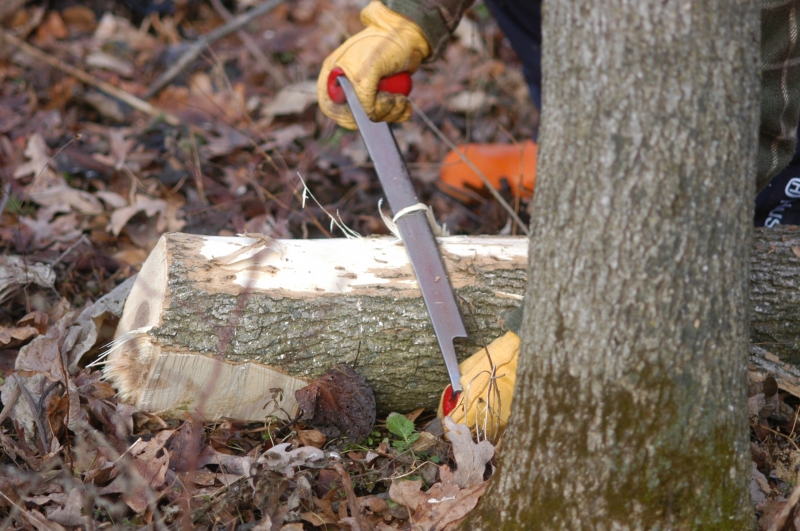
An trap tree under examination by an emerald ash borer survey crew in Wisconsin in 2006. EAB has been slowly working it's way east since it's discovery in Michigan in 2002. Photo: Wisconsin Dept of Natural Resources, Flickr Creative Commons, Some Rights Reserved.
Trap Trees
When I hear the phrase “trap tree,” an image of Charlie Brown’s kite-eating tree in the Peanuts comic strip comes immediately to mind. But trap trees, or sentinel trees, are meant to nab a much smaller airborne object, the emerald ash borer (EAB).
The idea is to make certain ash trees more attractive to EAB, to serve both as a monitoring tool and as a means of slowing the rate of ash death. Early in the growing season, a chosen ash tree is girdled, which stresses it and induces it to create certain phenols and alcohols not present in healthy trees. It is on this chemical signature that the adult emerald ash borers home in.
According to Aaron Barrigar, a Forest Conservation Technician with the Saint Regis Mohawk Tribe Environment Division, “Girdling ash by removing the bark and phloem around the entire circumference of the trunk creates an effective attractant for emerald ash borer. EAB adults lay more eggs on stressed ash trees than on healthy trees, which is why girdled ash are effective detection tools for the insect.”
An ideal trap tree can be any black, green or white ash between four and ten inches in diameter (as measured 4.5’ off the ground), but must be healthy and have full sun on at least one side. It should have easy access, and not be within striking distance of any utilities, roads or buildings. The tree is girdled in late May, shortly after leaf-out.
Barrigar cautions that while the bark must be cut through, the sapwood has to remain intact. “If you cut into the sapwood, it disrupts xylem cells that transport water. This can cause the trap tree to die and be ineffective as a trap. You want the tree to stay alive during the summer.”
After EAB emergence is over, usually in late fall, the trap tree is felled, limbed, and placed up on sawhorses. Using a sharp draw-knife, the bark of the entire trunk is carefully peeled to look for emerald ash borer galleries and larvae.
The Saint Regis Mohawk Tribe’s Environment Division began its sentinel tree program in 2013, far ahead of any surrounding communities. Trap trees are monitored in and around Mohawk territory at Akwesasne. Along with Barrigar, Wayne Samphier, also with the Saint Regis Mohawk Tribe’s Environment Division, heads up the program. Both are active members of the St. Lawrence County EAB Task Force, a volunteer group formed at the behest of Paul Hetzler, Natural Resources Educator with Cornell Cooperative Extension.
With a focus on community education and outreach, the EAB Task Force comprises foresters, arborists, utility managers, teachers, Village, Town and County officials, as well as concerned citizens. Given that EAB has been found in two locations in St. Lawrence County, one in Franklin County, and one in northern Oswego County very near the Jefferson County border, the EAB task force feels a particular urgency in getting the word out. The group is planning to create as many as twenty sentinel trees around St. Lawrence County this spring. The Mohawk Tribe’s Environment Division is even more ambitious, with plans for nearly two hundred.
In December 2017, one of Barrigar and Samphier’s trap trees in St. Lawrence County yielded several dozen live EAB larvae in addition to a maze of galleries. There was evidence that the tree, a green ash on the edge of a wetland in Robert Moses State Park, may have been infested for more than one year.
Cornell University and Cooperative Extension will present a class on managing EAB and another forest pest, the hemlock woolly adelgid, on April 12 from 8:30 AM to 3:00 PM at the Best Western University Inn in Canton. The class is geared toward land managers, pesticide applicators, arborists and other professionals, but the public is also welcome. NYSDEC Pesticide Recertification Credits are available in Categories 2, 3a, 6a, 9 and 10; SAF, ISA, and NYLT Credits pending approval.
Cost is $15.00, which includes lunch. Online registration is preferred at https://pub.cce.cornell.edu/event_registration/main/events_landing.cfm?event=AshBorer_240
Or call (315) 379-9192. For more information on this class or the EAB Task Force, email ph59@cornell.edu
For individuals or groups interested in undertaking a sentinel-tree project in their area, there will be a how-to class, with hands-on demonstration, in early May (date TBA). The class will be held at the St. Regis Mohawk Tribal Housing Authority, 378 NY-37, Akwesasne (near Rooseveltown NY). For more the course, or sentinel trees in general, email Aaron Barrigar at aaron.barrigar@srmt-nsn.gov
Cover Photo: Wisconsin Dept of Natural Resources, Flickr Creative Commons, Some Rights Reserved.

